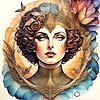HOME | DD
 Dragon-Gates — Ma'at Neteru of truth, justice and balance 6
[🤖]
Dragon-Gates — Ma'at Neteru of truth, justice and balance 6
[🤖]

#ai #ancient #angel #artwork #beautiful #celestial #detailed #digitalart #egypt #elegant #elf #etherial #fantasy #goddess #goldenratio #highfantasy #maat #mythology #portrait #princess #queen #realism #realistic #sciencefiction #aiart #digitalarwork #art
Published: 2023-07-07 06:19:22 +0000 UTC; Views: 1662; Favourites: 18; Downloads: 1
Redirect to original
Description
Maat, also spelled Ma'at or Ma'et, is an Ancient Egyptian Neteru who represents truth, justice, balance, and morality.
She is depicted as a woman who is either sitting or standing with a brilliantly glowing ostrich feather on her head, also she is depicted with wings. Maat was more than just a goddess to the ancient Egyptians. She represented the crucial concept of how the universe was maintained. The ancient Egyptians believed the universe had an order to it, and it was Maat who kept everything in balance. This helped the ancient Egyptians develop a strong sense of morality and justice.
Maat was also attributed with controlling the seasons of the year and the movement of the stars, which is why Egypt was called “the land of the Nile and Maat”
Maat represents the ethical and moral principles that all Egyptian citizens were expected to follow throughout their daily lives. They were expected to act with honour and truth in matters that involved family, the community, the nation, the environment, and God.
Maat as a principle was formed to meet the complex needs of the emergent Egyptian state that embraced diverse peoples with conflicting interests. The development of such rules sought to avert chaos, and it became the basis of Egyptian law.
From an early period, the king would describe himself as the "one who Maat loves".
The principles of Maat are extremely important in achieving the Afterlife. According to the Ancient Egyptian faith, after the death of the body, everyone had to pass through the Hall of Judgment, where a person’s heart was weighed on a scale.
The heart had to be lighter than a feather, which was the symbol of Maat, in order for the person to enter the Afterlife.
According to the Egyptian creation records, Maat was created when Ra and arose from the waters of Nun (chaos).
Maat was considered to be the daughter of Ra and was married to Thoth, god of wisdom.




















